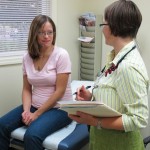Comparing Doctor Shortages In Small States

Emilie Ritter Saunders / StateImpact
Among states with fewer than 2 million people, Idaho has the least amount of doctors per capita.
Just because a state doesn’t have its own medical school, doesn’t mean it will have a higher proportion of doctors than states with med schools.
Take a look at this table showing states with populations of less than 2 million people. Fewer than half of these 14 states don’t have their own med school (although some, like Idaho, are part of an agreement to educate doctors through the University of Washington and University of Utah).
[spreadsheet key=”0AiLU6Cs5LWZIdFU0dDVyNWZyWTVTNURpZzg0Q3dScWc” source=”Idaho Board of Education Report | Association of American Medical Colleges” sheet=0 filter=0 paginate=0 sortable=0]
*States that send students to the University of Washington through the WWAMI program
Idaho is facing a shortage of physicians of all types, particularly general practitioners, and the state isn’t alone. Idaho has fewer doctors per capita than every state in the U.S. except Mississippi. And as Idaho’s physician workforce ages, that crunch will be exacerbated.
As the table above shows, Idaho doesn’t have its own medical school. Instead, it offers 28 seats per year for the cost of in-state tuition at the University of Washington and the University of Utah medical schools.
So, does access to medical education guarantee more doctors? Not in Nebraska.
Nebraska has two medical schools, Creighton and the University of Nebraska, yet it’s ranked 34th in the country in the number of physicians per capita. Nebraska has 219 doctors for every 100,000 people. Idaho has 184 per 100,000.
At the other end of the spectrum, Delaware doesn’t have its own med school, yet it’s ranked 14th in the nation for physicians per 100,000 people.
Recruiting doctors isn’t easy in rural states. Physicians can expect to work longer hours for less pay. As Dr. Ted Epperly explains, doctors in remote places are also often working on their own.
“There have to be a lot of things going right in a community to keep a doctors,” says Epperly. He says that often includes good schools and a decent small business community. “And then, if you don’t have health care in a community you can’t attract business or teachers. Health care, business and education are all interrelated,” Epperly says.



